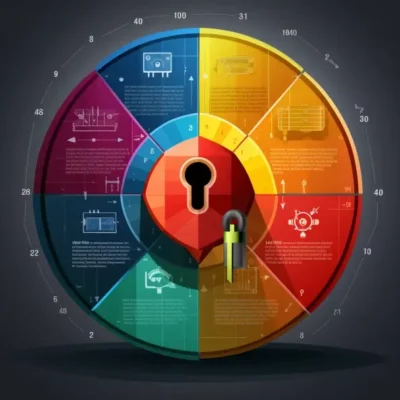As we continue to dive deeper into the digital era, an understanding of cybersecurity risk becomes critically important. Fulfilling that need, NIST Cybersecurity Risk Metrics acts as an authoritative benchmark for addressing cybersecurity risk factors in businesses of all sizes – from budding startups to large corporations.
Using NIST metrics to identify, assess, and prioritize risk in today’s interconnected world is crucial. This article aims to provide a comprehensive scan of the topic, shedding light on what these metrics imply, exploring their core components, and interpreting their practical implementation and impacts on business operations.
Understanding NIST Cybersecurity Risk Metrics
Decoding NIST Cybersecurity Risk Metrics – Necessity in the Digital Age
To slide into the heart of the subject without delays, NIST Cybersecurity Risk Metrics are benchmarks established by the National Institute of Standards and Technology (NIST), a U.S federal agency that develops and promotes measurements, standards, and technology to enhance productivity, facilitate trade, and improve the quality of life.
From a tech-enthusiast perspective, these metrics aren’t just some abstract guidelines. They are crucial tools, an automated manual that gives organizations in-depth agility to gauge their cybersecurity performance, evaluate risks, and implement improved defense strategies — a boon to those who prefer problem-solving technology over manual procedures.
Grasping the NIST Cybersecurity Risk Metrics
NIST’s specific standards and guidelines—particularly the NIST Special Publication 800-137—provide a comprehensive outline for security professionals to grasp these metrics better.
It offers a detailed approach to designing, implementing, and managing risk metrics in an info-sec program.
Stripped down to the basics, these Risk Metrics can be boiled down to three foundational components:
- Threat Event Frequency Metric: This measures the rate at which cyber threats occur over a particular period, helping organizations determine the magnitude of the risk.
- Vulnerability Metric: It translates the likelihood of a system vulnerability being exploited or misused, enabling an organization to pinpoint and patch vulnerability points.
- Impact Metric: It indicates the extent of potential damage that could occur from a successful cyber-attack. It aids in decision-making relating to resource allocation and security strategy.
The Significance: Why are NIST Cybersecurity Risk Metrics Vital?
The current digital landscape is riddled with multitudes of complex cybersecurity threats growing in sophistication and frequency. In this context, NIST risk metrics emerge as a rational, analytical approach to tackling these challenges head-on.
NIST Cybersecurity Risk Metrics empower organizations to respond to threats proactively. By providing measurable data, organizations can objectively analyze their cybersecurity stance and potential risks and gauge the effectiveness of deployed solutions.
Also, these metrics fuel transparency, enabling easy comprehension and communication of cybersecurity risks among stakeholders. The practical, automated analysis offered by NIST metrics certainly reduces the time and human effort required in manual processing.
Moreover, compliance with legally mandated regulations such as HIPAA or Sarbanes-Oxley becomes streamlined by adhering to NIST guidelines.
This uniformity of standards allows organizations to maintain a strong defense posture while staying within the legal framework.
Bottom Line
In the vast sea of cybersecurity, NIST Cybersecurity risk metrics are a robust lighthouse – reliable, precise, and comprehensive.
They establish a significant backbone for an organization’s cybersecurity program, turning subjective risk judgments into analytical, objective evaluations. Let’s embrace them as an instrumental tool to bolster cybersecurity defenses in any organization.

The Key Components of NIST Cybersecurity Risk Metrics
Delving Deeper: Examining the Core Components of the NIST Cybersecurity Risk Metrics
Skipping the typical introductions, let’s dive straight into the NIST Cybersecurity Risk Metrics components unaddressed in previous sections.
Leveraging these metrics optimizes an organization’s capacity to identify, manage, and mitigate cyber threats. However, understanding the overlooked elements— Control Effectiveness, Threat Capability, and Risk Determination— is fundamental to fully appreciating their ingenious nature.
Control Effectiveness sits at the core of cybersecurity risk metrics, representing the capacity of preventative measures to ward off potential threat events.
In the context of NIST, it’s not just about installing firewalls or encryption tools. Instead, a comprehensive measure of control effectiveness encompasses administrative, technical, and physical controls.
This manifests as well-executed security policies, sophisticated intrusion detection systems, and carefully controlled physical access points.
Then comes the metric of Threat Capability, which quantifies an attacker’s potential. While often underestimated, this metric allows organizations to assess and anticipate potential hacker threats.
This parameter focuses on everything from an adversary’s technical proficiency and resources to their motivation and persistence. The more potent the attacker, the higher the threat capability.
Lastly, we turn our attention to Risk Determination. This is where the individual components of the NIST framework come together to paint a holistic picture of an organization’s security posture.
It’s a comprehensive calculation, factoring in aspects such as threat event frequency, vulnerability, impact, control effectiveness, and threat capability. The output of this assessment produces a quantifiable representation of an organization’s cybersecurity risk.
However, the thirst for improvement should not end there. Risks are continuously changing and new threats are constantly emerging.
This necessitates an organization to launch into a continuous review process that adapts and evolves based on Risk Monitoring – a dynamic and essential component of the NIST framework.
Risk Monitoring involves an ongoing evaluation of implemented controls and overall Risk Determination to ensure the cybersecurity defenses remain robust and relevant.
Two additional elements— Risk Response and Risk Reporting— need focus to ensure the metric system is actioned efficiently and effectively.
Risk Response involves deciding and implementing the best method to tackle the identified risks, be it mitigating, transferring, accepting, or avoiding them. At the same time, Risk Reporting is significant for understanding, communicating, and supporting decision-making based on the identified risk calculations.
NIST’s innovatively contrived Cybersecurity Risk Metrics present a comprehensive, quantifiable outlook on an organization’s cybersecurity framework.
It supports the critical objectives of identifying and managing potential risks, setting the tone for a proactive and resilient security culture.

Adoption and Implementation of NIST Cybersecurity Risk Metrics
Diving straight into the mechanics, Control Effectiveness is a crucial component when it comes to implementing NIST Cybersecurity Risk Metrics within a business.
Evaluating your company’s current control measures can help identify areas needing improvement, such as network integrity, data privacy, and authentication practices.
If the protective measures aren’t up to the task, they need a revamp – and pronto!
Moving on to Threat Capability, it’s all about understanding potential threats and the level of sophistication they might carry.
Businesses need to be on high alert for the threats they’re facing and the more advanced ones looming. It pushes you to stay on top of evolutions in threat profiles and identify vulnerabilities that might not yet have been exploited.
Risk Determination brings all the data points together. Drawing from the frequency of threats, the vulnerability of systems, and potential impact, effective risk determination relies on comprehensive data analysis.
It lets you decide if the resumed activity is worth the cybersecurity risk, guiding the all-important decision-making process.
Once the risks have been identified, it’s onto Risk Monitoring. Staying ahead of the curve means vigilance – constantly keeping an eye on your organization’s threat landscape and updating your risk analysis accordingly.
Real-time monitoring is no longer a nice-to-have feature but a critical tool in the modern cybersecurity toolkit. It keeps your finger firmly on the pulse of your network’s security status.
Similarly, Risk Response deals with how you act upon the data and insights collected. Quick, informed, and decisive reactions are vital in the event of security breaches or threats.
A meticulous response plan governing containment, eradication, and recovery forms the bedrock of shoring up your defenses. Having a plan means you can act within moments of an anomaly detection.
Finally, it’s all about Risk Reporting. Communication, often overlooked, is key to a cybersecurity strategy. Effective reporting mechanisms ensure that everyone, from technical staff to C-suite executives, is aware of risks, mitigation efforts, and the overall health of the company’s cybersecurity.
Shifting to a risk-centric approach, embodied by the NIST Cybersecurity Risk Metrics, enables businesses to effectively identify, assess, manage, and reduce cybersecurity risks.
Adopting these measures enhances the existing security infrastructure and cultivates a culture of cybersecurity resilience within the organization.
It is not just a solution but an ongoing process – a relentless pursuit to ensure the highest level of safety in cyberspace. Now that’s a smart move.

The Impact of NIST Cybersecurity Risk Metrics on Businesses
Unearthing the Impact of NIST Cybersecurity Risk Metrics on Business Operations
Dipping into control effectiveness is imperative, influenced significantly by implementing NIST Cybersecurity Risk Metrics.
These guidelines offer an opportunity to reevaluate control measures promptly and address potential loopholes, thus tightening the security fabric.
Understanding these measures facilitates a laser-sharp focus on areas of improvement, a step ahead in avoiding potential breaches.
Comprehending threat capability helps businesses recognize and address potential risks. In the face of unmitigated cyber threats, being technically informed plays a crucial role.
NIST metrics help here, offering a broad landscape view of potential threats and guiding businesses with actionable intelligence to counteract such threats.
Risk determination carries much weight in cybersecurity assessments, with comprehensive data analysis framing its backbone.
NIST Cybersecurity Risk Metrics enable business leaders to quantify risk – a key element in developing a robust business continuity strategy. Businesses can use data analysis to predict and protect against digital threats.
The real-time monitoring facet that the NIST Risk Metrics provides towers above many other cybersecurity strategies.
Continuous monitoring of system activities allows businesses to manage threats proactively.
Businesses can enhance cybersecurity by proactively identifying anomalies and taking preventative measures before they cause system-wide disruptions.
Constructing a solid risk response plan, another significant aspect of NIST Cybersecurity Risk Metrics, lets businesses actively respond to security breaches.
From identification to containment and elimination, having an organized response plan allows businesses to arrest potential threats promptly, preventing widespread damage.
Effective risk reporting, a byproduct of the NIST metrics, encourages open communication within organizations, facilitating prompt and decisive actions against potential threats.
Simultaneously, it ensures directors and key stakeholders accurately understand the cybersecurity landscape. This transparency fosters a culture of cybersecurity vigilance throughout the organization.
Adopting a risk-centric approach with NIST Cybersecurity Risk Metrics spells a long-term game plan for businesses. Organizations can enhance cybersecurity by adopting these metrics. They can identify vulnerabilities efficiently and strengthen security infrastructure.
Indubitably, such an approach helps to future-proof vital business assets in this rapidly evolving digital world.
The NIST Cybersecurity Risk Metrics aren’t merely tools but a paradigm shift in how we perceive and tackle cybersecurity risks. Implementing these metrics can improve efficiency and protect against unforeseen digital shifts.

Conclusion
The volatile digital security landscape urges businesses to brace themselves with robust risk management strategies. NIST Cybersecurity Risk Metrics are such potent tools that can transform businesses’ approach towards cybersecurity.
Systematically identifying and addressing threats and vulnerabilities and planning efficient incident responses, NIST metrics strengthen an organization’s cybersecurity.
Additionally, they streamline the process of response mechanisms, boosting the business’ resilience in the face of potential security breaches.
As we envelop our operations with more technology, adopting a metrics-guided approach to cybersecurity isn’t just an option; it’s a profound necessity to protect and propel business in this digital epoch.

Chris Ekai is a Risk Management expert with over 10 years of experience in the field. He has a Master’s(MSc) degree in Risk Management from University of Portsmouth and is a CPA and Finance professional. He currently works as a Content Manager at Risk Publishing, writing about Enterprise Risk Management, Business Continuity Management and Project Management.

